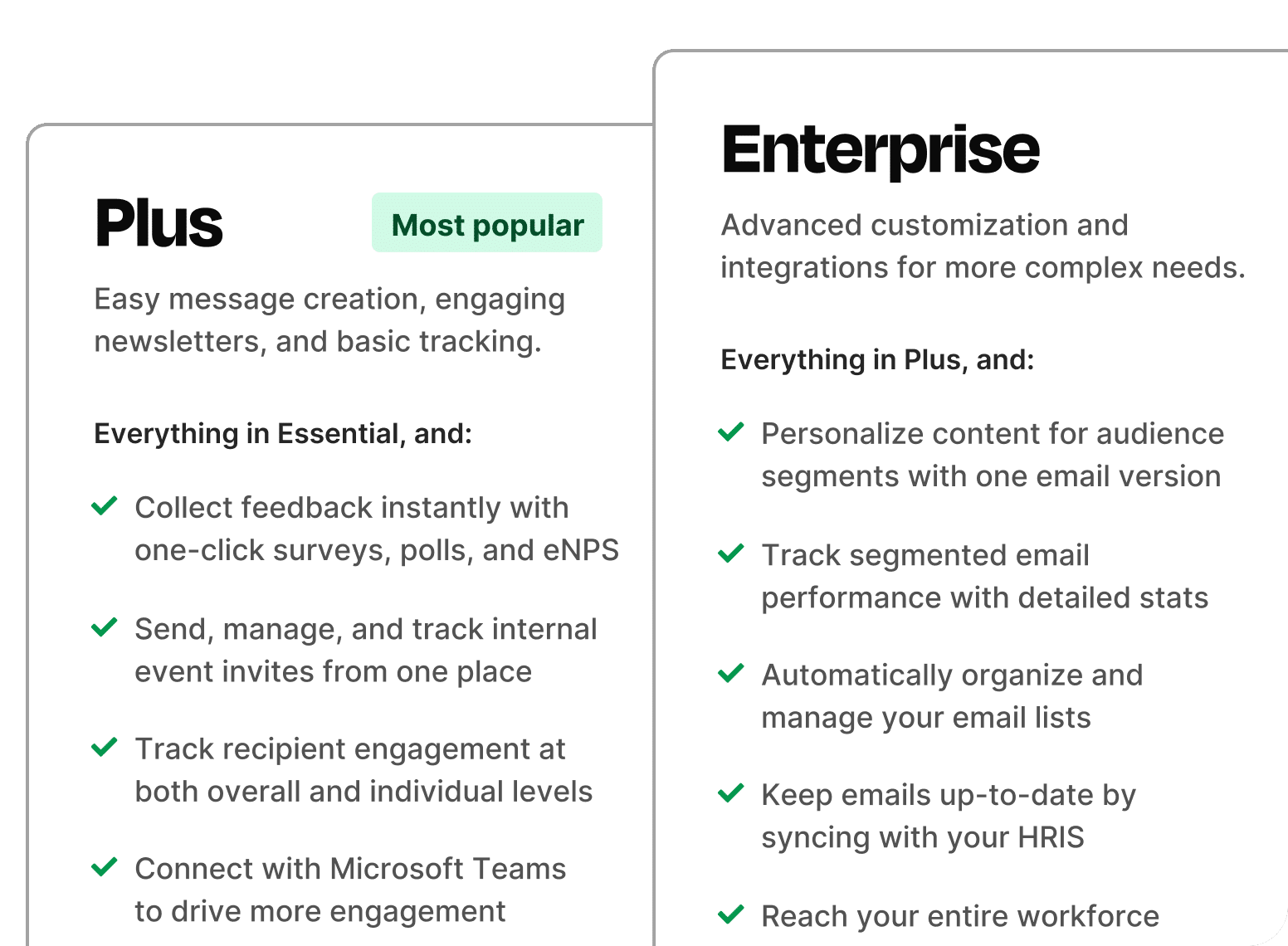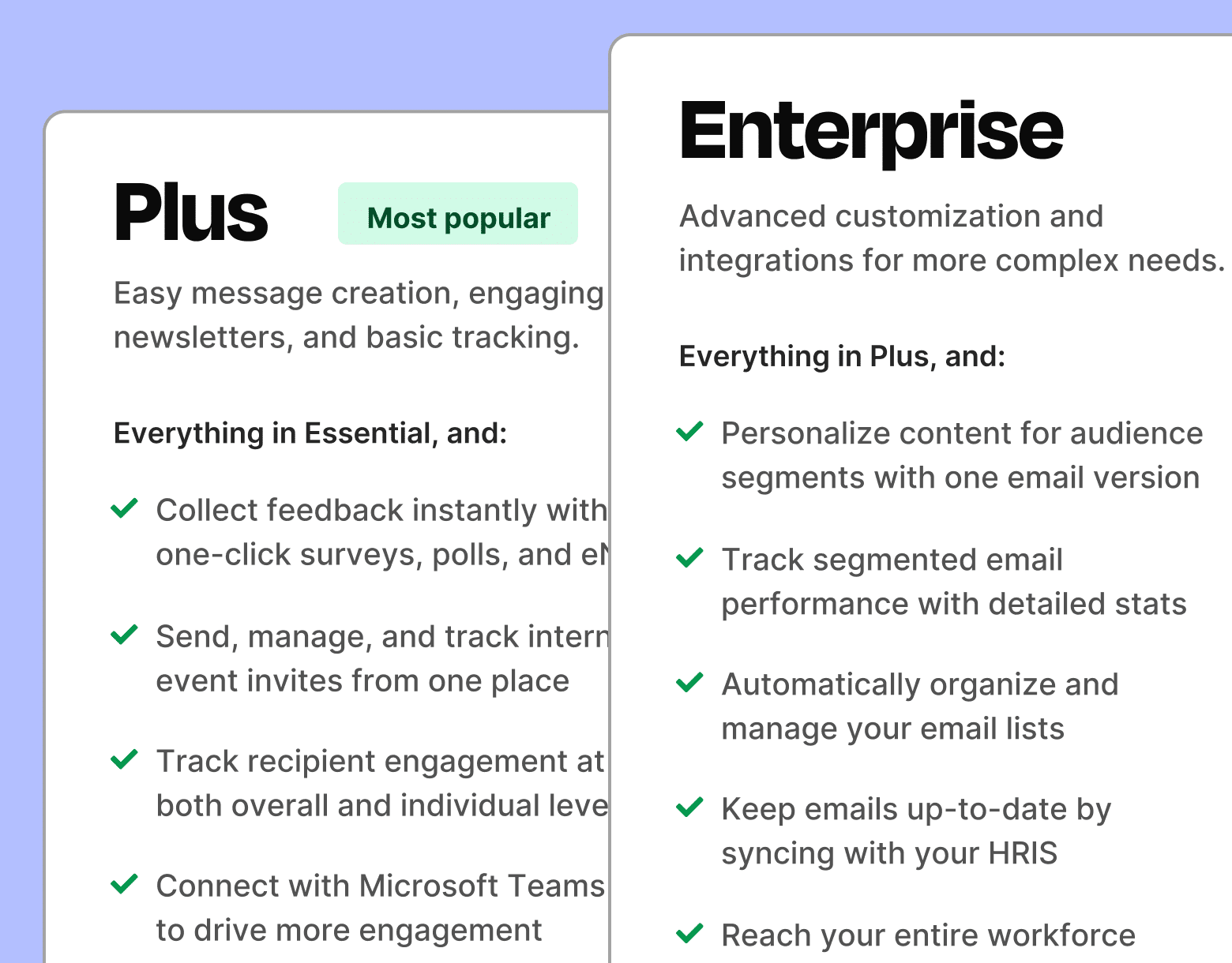Securing an internal communications budget is a key part of fostering employee engagement. Yet, more than 50% of internal communications professionals believe that they lack the resources to perform well in their tasks. Here’s how you can move the needle and get a bigger internal communications budget by next quarter.
Internal communications impact just about every area of business—from employee engagement and retention to customer loyalty. But, to unlock the full potential of your internal communications strategy, you need the resources to make it happen. That means securing a budget that reflects the importance of these efforts.
Many organizations struggle to secure an internal communications budget due to perceived intangibility—benefits like engagement and culture are often challenging to quantify. Competing priorities can also push internal comms down the list in favor of departments with clearer ROI. Additionally, decision-makers may not fully grasp the strategic impact of effective communication on overall business performance, resulting in underinvestment. What’s the solution? It deals with demonstrating measurable results and aligning communications efforts with broader business goals.
This guide will teach you how to secure a bigger internal communications budget and show your team the value of investing in the employee experience.
Take a self-guided tour of ContactMonkey
See how our key features can streamline your internal communications.
Take product tour

What Is the Value of Internal Communications?
The value of internal communications lies in its ability to create a connected, informed, and engaged workforce. It enhances employee engagement by fostering a culture of transparency and trust, aligning employees with the company’s mission and goals.
Effective internal communication also improves productivity by reducing misunderstandings and promoting clarity. Plus, it plays a key role in retaining talent by making employees feel valued and heard, while also supporting diversity and inclusion initiatives and strengthening the organization’s ability to manage crises and changes effectively.
What Are the Roles of Internal Communication Pros and Departments
Internal communications professionals make a difference in just about every area of business. But you’ll need to demonstrate this to individuals who might not know the ins and outs of the internal communications field.
Before sending in your internal communications budget proposal, list all the tasks your team is responsible for. Organize them into categories or “buckets” that demonstrate their impact.
For instance, common internal communications team responsibilities might be divided as:
- Content creation and knowledge sharing
- Departmental alignment
- Supporting/facilitating the communications needs of teams and leaders
- Growing company assets by improving employee experience and talent retention
Once you have a clear idea of what your team is achieving, it’ll be easier to demonstrate the impact of internal communications on business as a whole. When it comes to asking for a bigger internal communications budget, showcasing the achievements of your team will lay the groundwork for your proposal.


Why You Need a Bigger Internal Communications Budget
Remember all those internal communications benefits we discussed earlier? To achieve them at scale, you need to invest in the quality and reach of your employee communications.
Research shows that increasing employee engagement investments by 10% can raise business profits by up to $2,400 per employee. Per year.
How is this possible? Simple: informed employees lead to engaged employees. Workers who are actively engaged at your company stay longer, make a bigger impact, and contribute more to business growth.
Inversely, the costs of employee disengagement can be devastating, with losses of up to $350 billion a year across the US alone.
To avoid the impacts of a disengaged workforce, and reap the benefits of an engaged one, getting an appropriate internal communications budget is essential.
How Can Budget Impact Internal Communications?
Unlock Internal Comms Superpowers
Discover why 10,000+ rely on us. See the internal email and employee newsletter platform in action.
Book demo

What to Consider Before Building Out an Internal Communications Budget
Before estimating an internal communications budget, it’s important to understand your internal communication goals and the metrics behind them.Brainstorm everything you’ll need in your internal communications budget by using these questions to guide you:
- How much does workplace turnover cost your company annually?
- What is your company’s employee net promoter score (eNPS)?
- Does client loyalty help grow your business revenue?
- How is your customer service team performing?
- Were there any instances of lost revenue due to a lack of information/misunderstanding among staff?
- Do your internal communications directly impact the quality of your customer service or product/services?
What Should Be Included in an Internal Communications Budget
Your internal communications budget should include all of the resources you might need to achieve your internal communications goals. These include:
- Internal communications tools: Allocate funds for email platforms, intranet software, and employee communication apps.
- Content creation: Budget for video production, graphic design, and copywriting to create engaging materials.
- Training and development: Invest in training to keep your communications team up-to-date with trends and tools.
- Analytics and reporting: Include tools to measure impact and demonstrate the business case for internal communications.
- Crisis communication planning: Ensure resources are available for timely responses during emergencies.
🐒 PRO TIP: Determining what exactly to include in your internal communications budget requires a specific thinking process. First, know what you want to achieve. Then, work backwards.
Say your internal communications goals include increasing employee awareness and engagement. How will you measure success? Will it be by calculating email open rates or clicks? Or will you be checking up on intranet engagement? What tools will you need to measure internal communications performance?
Probe more deeply behind each of your internal communications goals to know exactly what to include in your internal communications budget.
What Is a Typical Budget for Internal Communications?
The cost of an internal communications department can vary widely depending on company size, industry, and the scope of the communication strategy. For a mid-sized company, the typical internal communications budget might range from $50,000 to $300,000 annually. This covers tools, content creation, salaries, training, and reporting software.
Larger companies may allocate $500,000 or more, depending on the complexity of their communications needs, including crisis communication, global messaging, and comprehensive employee engagement initiatives. Estimating an internal communications budget requires considering tools, staff, and the overall business case.
How to Prioritize Your Internal Communications Budget
When allocating and prioritizing your internal communications budget, consider how the money will be used based on the areas that yield the highest impact:
Communication tools: Start by investing in tools that enhance communication efficiency, such as email platforms, intranet, and employee engagement software. These tools are critical to ensuring seamless communication across departments and remote teams.
Content creation: High-quality content like videos, newsletters, and infographics drives engagement and keeps employees informed. Prioritize professional production for clarity and impact.
Analytics and reporting: Invest in analytics tools to measure the effectiveness of your internal communications efforts. These tools help track open rates, engagement metrics, and feedback loops, justifying future investments.
Training and development: Prioritize staff training to ensure your team can effectively utilize communication tools and stay up-to-date on best practices. This helps improve the overall effectiveness of your internal communications strategy.
Crisis communication resources: Set aside part of your budget for crisis communication to ensure the organization is prepared to respond effectively during emergencies. This ensures timely and clear communication during critical moments.
These areas directly impact how well internal communications perform, influencing engagement, productivity, and business outcomes. By investing strategically in these areas, you ensure that communication efforts align with business objectives, engage employees effectively, and demonstrate measurable value.
Take a self-guided tour of ContactMonkey
See how our key features can streamline your internal communications.
Take product tour

How to Create a Compelling Business Case for Internal Communications: 5 Steps
Your internal communications team might readily see the benefits of a bigger internal communications budget. But, not everyone will see things your way. And, it can be difficult to communicate the advantages you’re so sure of to the rest of the team.
A business use case will help give structure to your ideas. It will enable you to clearly show how your proposed budget will improve internal communications and impact business as a whole.
Here are 5 components of a persuasive business case for your internal communications budget:
1. Align your internal communications budget with business goals
To effectively align internal communications with business goals, directly tie communication efforts to measurable outcomes like employee engagement, retention, and productivity. For example:
- Employee engagement: Show how clear, timely communication fosters a connected and motivated workforce, leading to higher engagement scores and employee satisfaction.
- Employee retention: Effective internal communication helps retain top talent by fostering a culture of transparency, recognition, and inclusion. Link this to reduced turnover costs.
- Productivity: Highlight how streamlined communication reduces inefficiencies, misunderstandings, and time wasted, leading to improved team productivity and project outcomes.
By clearly demonstrating these connections, you present internal communications as an essential driver of organizational success, directly impacting profitability and growth.
🐒 PRO TIP: Our internal email benchmark report will come in handy when establishing your goals.
2. Highlight the benefits of internal communications using data
Improved internal communications have a direct impact on both employee retention and performance, which are critical business objectives. You’ll need to prove this using data, however. Here are just a few stats from our Global State of Internal Communication (GSIC) report that you can share decision-makers to make a strong business case for internal communications:
- Staff engagement: Companies with effective internal communication see up to 25% higher employee productivity.
- Organizational alignment: 69% of employees report feeling more aligned with company goals when internal communications are clear and consistent.
- Retention: Organizations with strong internal communication are 50% more likely to retain top talent.
- Crisis management: 72% of leaders say internal communications were pivotal in successfully managing crises.
Further, Gallup research reports that highly engaged business units experience the following:
- Increased attendance: Highly engaged employees reduce absenteeism by 81%, showing up to work more consistently.
- Boosted productivity: Engaged employees drive an 18% increase in productivity, particularly in sales performance.
- Lower turnover in high-turnover organizations: Engaged business units experience 18% less turnover in high-turnover industries.
- Dramatic retention gains in low-turnover organizations: In industries with lower turnover, highly engaged units see a 43% reduction in turnover, showcasing even greater retention benefits.
3. Showcase real-life examples through case studies
To build a strong business case for internal communications, real-life case studies can be powerful tools in demonstrating value. For example, you can showcase how a company improved its internal communications using a tool like ContactMonkey and saw direct results, like:
- Improved frontline communication: First Onsite used SMS to effectively reach employees in the field, increasing engagement and information sharing.
- Higher engagement rates: Joules achieved email open rates of over 90% by optimizing their internal communications with ContactMonkey.
- Avoiding unsubscribes: Thumbtack switched to ContactMonkey, reducing unsubscribes and maintaining high engagement through better-targeted messaging.
- Custom communications: IDP leveraged data-driven strategies to tailor their internal communications, enhancing relevance and effectiveness.
4. Describe your internal communications solution
Outline the value of a bigger internal communications budget by identifying the solution to your internal comms challenges. Be discerning and highlight how your solutions works in practice. We drafted a sample below of how you could present your argument for a tool like ContactMonkey – tweak as you see fit!
ContactMonkey’s internal communications solution is designed to streamline employee messaging and increase engagement through personalized, data-driven communication tools. The platform integrates seamlessly with Outlook and Gmail, allowing internal communicators to send and track emails without leaving their inboxes. With features like real-time analytics, segmentation, and personalized email templates, ContactMonkey ensures that messages reach the right people at the right time. This comprehensive solution helps organizations improve employee engagement, measure communication effectiveness, and optimize strategies based on actionable insights.
5. Identify KPIs and timeframe to implement your solution
Wrap up your proposal by outlining the timeframe for implementing your internal communications solution and recapping the key performance indicators (KPIs). Ask yourself, which metrics will show that your new budget generated net gains for your business? When is the realistic deadline to obtain these metrics?
If your goal is to increase email open rates by 10% by the end of Q4, and boost event registrations by 5%, indicate this clearly. Then, summarize how the new budget will help.
Craft a winning internal comms budget proposal
Take the guesswork out of budgeting. Use our free template!
Get the template

How to Get Your Budget Approved
To make a strong business case for a bigger internal communications budget and boost your chances of approval, consider these best practices:
Communicate benefits strategically: clearly demonstrate what business need(s) your new budget will address and how you’ll be able to measure and demonstrate success. Say you’re trying to get more event registrations, and you want a tool that makes event management easier. Show how this tool might increase RSVPs, boost event participation, and lead to higher employee engagement.
Leverage data: when getting budget approval, numbers are more compelling than words. Use your own internal communications analytics alongside industry benchmarks to show how your company squares up to others in the industry. ContactMonkey’s internal email benchmark report will come in handy for this task.
Demonstrate cost savings: Show your CEOs and procurement teams that they’ll get bang for their buck in the long run. If a new internal communication software will help boost employee engagement and increase retention, estimate the cost savings for these employees. For reference, consider that when an employee leaves, it takes between 50% to 150% of their salary to replace them. So it’s more profitable to engage and retain employees.
Show time savings: demonstrate how a bigger budget will allow you to implement a tool or initiative that improves workplace productivity. You can enlist employee feedback and conduct a survey asking employees how much time they spend on average looking for internal resources. Then, demonstrate how your new software will resolve this challenge and boost productivity.
What to do if Your Internal Communications Budget Doesn’t Get Fully Approved
If your budget doesn’t get approved, don’t sweat it. Often, a budget isn’t approved when there simply isn’t enough data to make a strong business case. Your company might also be in a tight spot financially and may revisit the proposal at a later date.
Keep vigilant and continue to gather more analytics, including email open rates, clicks, and employee feedback. Compare quarterly performance and use the insights you gather to make an even stronger business case for increasing your internal communications budget.
When it comes time to revisit the budget, you’ll have a bigger chance of success if you have more data points to drive your proposal.
Show the ROI of Internal Communications With ContactMonkey
In a perfect world, internal communicators would have a huge budget to communicate company news, initiatives, and urgent information to employees. In reality, that’s hardly ever the case. To get an internal communications budget suited to your goals, you’ll need to make a strong business case.
Use data to show the tangible benefits of your new budget; these analytics are the best way to get buy-in from management—now and into the future.
With ContactMonkey’s powerful email analytics, it’s easier to build a data-driven internal communications strategy. Book a free demo with one of our dedicated team members to learn how to build a strong Business Use Case for ContactMonkey.




